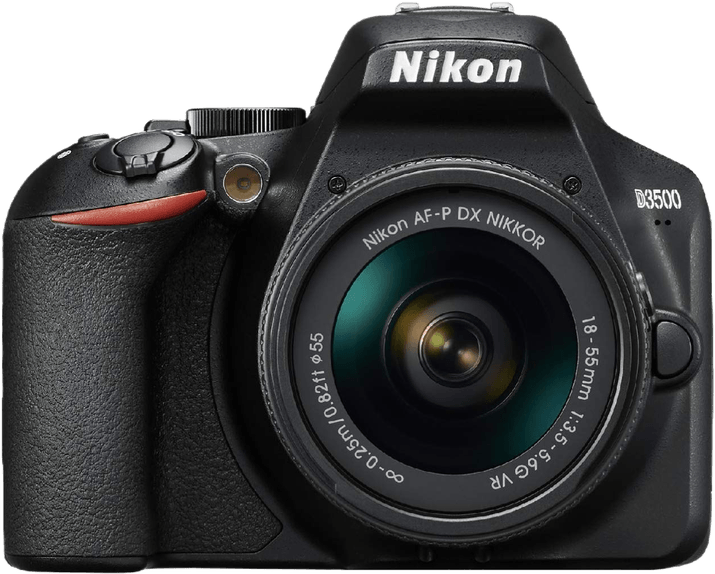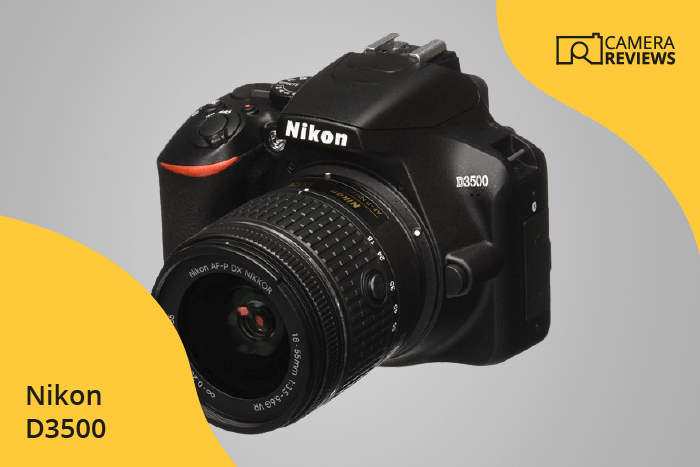Nikon D3500 Specs and Scores

The Nikon D3500 scores a 61/100 in our evaluation. This DSLR camera was announced on 08/30/2018 and released the same year with a launch price of $499.95. The camera measures 124 x 97 x 70mm and weighs 615g, or 1.36lbs.
In the competitive camera market, the D3500’s specifications hold up decently. Its size and weight make it a portable and user-friendly option for both beginners and enthusiasts. The score of 61, while not groundbreaking, shows that the Nikon D3500 is a reliable choice for those seeking a solid DSLR experience.
Nikon D3500 Overview and Optics
The optics of the Nikon D3500 receive a score of 65/100. This camera boasts 24 megapixels and a shooting speed of 5 frames per second. It utilizes a CMOS sensor, Expeed 4 processor, and has a DXOMARK score of 87 for its sensor. The sensor size is APS-C, and the camera uses a Nikon F lens mount. However, it lacks image stabilization and has an aspect ratio of 3:2.
These specifications position the Nikon D3500 as a solid entry-level DSLR in today’s market. Its sensor size and megapixel count allow for high-quality images, and the Expeed 4 processor ensures fast performance. The Nikon F lens mount provides compatibility with a wide range of lenses, offering flexibility for various shooting scenarios.
Despite its strengths, the lack of image stabilization may result in less sharp images, especially in low-light conditions or when using longer focal lengths. The Nikon D3500 is a reliable choice for beginners, but more advanced photographers may seek additional features for optimal performance.
Nikon D3500 Video Performance
The Nikon D3500 has a video score of 56 out of 100. This score is due to its various video specifications, which include a maximum video resolution of Full HD (1920×1080) and a maximum video frame rate of 60fps. However, it lacks a built-in time-lapse functionality.
In today’s market, the Nikon D3500’s video capabilities are average. Full HD resolution is standard, but many modern cameras offer 4K video recording, which provides higher resolution and better image quality. The 60fps frame rate is acceptable, but not exceptional. The absence of built-in time-lapse functionality is a drawback for those seeking this feature in their camera.
The Nikon D3500’s video capabilities are decent for casual users but may not satisfy those seeking advanced video features or higher resolution.
Nikon D3500 Features and Benefits
The Nikon D3500 features a score of 54/100, which reflects its capabilities in the current market. With a 3-inch screen size and a resolution of 921,600 dots, the display is adequate for reviewing images but lacks a touchscreen interface. The absence of a flip screen limits the camera’s versatility in certain shooting situations.
Notably, the D3500 does not include GPS or WiFi connectivity, which are common features in many modern cameras. However, it compensates by offering Bluetooth connectivity, allowing users to transfer images wirelessly to compatible devices.
Taking these specifications into account, the Nikon D3500 is a decent entry-level DSLR camera but may not fulfill the requirements of more advanced photographers seeking additional features and connectivity options. The camera’s feature score of 54/100 reflects its position in the competitive market, catering to those who prioritize simplicity and affordability.
Nikon D3500 Storage and Battery
The Nikon D3500 receives a storage and battery score of 48/100. This camera has a single memory card slot, accepting SD, SDHC, and SDXC cards. In comparison to other cameras in the market, the Nikon D3500 falls short in terms of storage options, as many competitors offer dual card slots and support for faster memory cards.
The battery life of the Nikon D3500 is impressive, offering 1550 shots per charge with its EN-EL14a battery. However, it lacks USB charging, which is a disadvantage compared to other cameras that provide this convenient feature. This limitation may affect the camera’s practicality for on-the-go photographers.
Considering the storage and battery capabilities of the Nikon D3500, it is evident that there is room for improvement. While its battery life stands strong, the lack of USB charging and limited storage options hinder its overall performance in today’s competitive camera market.
Nikon D3500 Alternatives
Do you want to know how the Nikon D3500 compares to its competitors? Have a look at the most popular comparisons for this camera below:
- Nikon D3500 vs D5600
- Nikon D3500 vs D5300
- Nikon D3500 vs Z50
- Nikon D3500 vs D5100
- Nikon D3500 vs D7500
- Nikon D3300 vs D3500
Nikon D3500 FAQ
Does the Nikon D3500 Have Built-in Image Stabilization?
No, the Nikon D3500 does not have built-in image stabilization. However, it does support lenses with VR (Vibration Reduction) technology for image stabilization.
Does the Nikon D3500 Support 4K Video Recording?
No, the Nikon D3500 does not support 4K video recording. The maximum video resolution it offers is Full HD 1080p at 60fps.
What Size Sensor Does The Nikon D3500 Have?
The Nikon D3500 features an APS-C sized sensor, specifically a 24.2-megapixel DX-format CMOS sensor, which provides excellent image quality and detail.
Does the Nikon D3500 Have a Dual Memory Card Slot?
No, the Nikon D3500 has only one memory card slot, which supports SD, SDHC, and SDXC cards.
Does the Nikon D3500 Have a Touch Screen?
No, the Nikon D3500 does not have a touch screen. It is equipped with a 3-inch fixed LCD screen for image review and menu navigation.
Does the Nikon D3500 Have Wi-Fi and Bluetooth?
The Nikon D3500 does not have built-in Wi-Fi, but it does feature Bluetooth connectivity for wireless image transfer and remote control using Nikon’s SnapBridge app.
Does the Nikon D3500 Have GPS?
No, the Nikon D3500 does not have built-in GPS functionality. However, you can still geotag your photos using the GPS data from a connected smartphone via the SnapBridge app.
Is the Nikon D3500 Weather Sealed?
No, the Nikon D3500 is not weather sealed, so it is recommended to use caution when shooting in harsh weather conditions or environments with dust and moisture.
Does the Nikon D3500 Have a Built-in Flash?
Yes, the Nikon D3500 has a built-in pop-up flash, which provides additional lighting when needed, especially in low-light situations.

